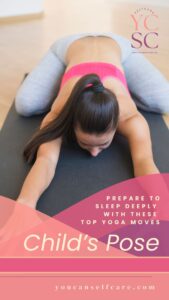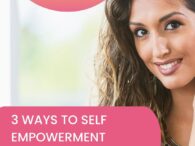Are you tired of tossing and turning at night, struggling to get a good night's sleep? Well, guess what? You're in luck! By mastering these top yoga moves, you can prepare yourself to sleep deeply and wake up feeling refreshed and rejuvenated. Coincidentally, these yoga poses not only promote relaxation but also help release tension from your body. So why not give them a try?
First up is Child's Pose, an incredible stretch for your back and hips that will instantly calm your mind. Follow that with Legs-Up-The-Wall Pose, which allows gravity to work its magic on your legs and brings a sense of serenity to your entire body. Need to let go of stress? Forward Fold is the perfect pose for you.
But we're not done yet! Corpse Pose will help you completely surrender and unwind before bed. And don't forget about Shoulder Stand - it improves blood circulation and relieves anxiety.
To really enhance the benefits of these yoga poses, try incorporating Alternate Nostril Breathing into your bedtime routine. This technique balances both sides of your brain and prepares you for a deep slumber.
So get ready to master these top yoga moves and prepare yourself for the best sleep of your life!
Child's Pose
Get ready to sink into a state of bliss as you curl up like a cozy little child in Child's Pose. This simple yet powerful yogapose is perfect for preparing your mind and body for a deep, restful sleep.
Child's Pose offers numerous benefits, such as gently stretching your hips, thighs, and ankles while also calming your nervous system. It can even help relieve stress and anxiety, allowing you to let go of any tension from the day.
To deepen your stretch in Child's Pose, try widening your knees apart or placing a bolster or blanket under your torso for support. You can also extend your arms forward or bring them back alongside your body to find the variation that feels best for you.
So get ready to embrace tranquility with this soothing pose before drifting off into dreamland.
Fountain Pose
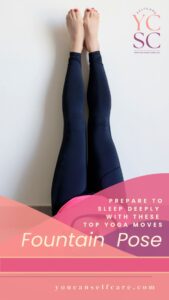
To release tension in your legs, improve circulation, and relax your nervous system, try practicing the Legs-Up-The-Wall or Fountain pose.
This pose involves lying on your back with your legs extended up against a wall, allowing gravity to help alleviate any tightness or discomfort in your lower body. By elevating your legs in this way, you can increase blood flow and reduce swelling or fatigue.
Additionally, this gentle inversion calms the nervous system and promotes deep relaxation for a restful night's sleep.
Release Tension in Your Legs
Easing tension in your legs can be achieved through these top yoga moves, allowing for a deeper and more restful sleep. One effective way to release tension in your legs is by practicing the Legs-Up-The-Wall Pose. This pose not only helps relieve leg pain but also increases flexibility.
By lying on your back with your legs extended up against a wall, you allow gravity to gently stretch the muscles in your legs, promoting relaxation and reducing any built-up tension. As you hold this pose, focus on deep breathing and consciously letting go of any tightness or discomfort.
With regular practice, you'll notice improved circulation and a greater range of motion in your legs, which ultimately contributes to a more peaceful night's sleep. So why not give it a try tonight? Your well-rested self will thank you tomorrow!
Improve Circulation
By incorporating specific yoga poses and mindful breathing techniques, you can effectively enhance blood flow and promote optimal circulation throughout your body. These practices are essential for those seeking mastery in improving their overall well-being.
Not only do these techniques increase blood flow, but they also boost energy levels, leaving you feeling revitalized and ready for a deep and restful sleep.
Poses such as the Legs Up the Wall pose or the Corpse pose help to alleviate tension in the legs while simultaneously allowing gravity to assist in increasing blood flow back towards the heart.
Additionally, conscious breathing exercises like Kapalabhati breath or Alternate Nostril breathing activate the respiratory system, further enhancing circulation by oxygenating your cells.
By incorporating these yoga moves into your bedtime routine, you can experience improved circulation and a more peaceful night's sleep.
Relax Your Nervous System
Relaxing your nervous system is like releasing a tight knot, allowing your body to unwind and find tranquility. To achieve this, there are various relaxation techniques you can practice before bedtime.
Deep breathing exercises, such as diaphragmatic breathing, help activate the parasympathetic nervous system, promoting a state of calmness and reducing stress levels.
Another effective method is progressive muscle relaxation, where you systematically tense and relax each muscle group in your body. This technique helps release tension and promotes deep relaxation.
Additionally, practicing mindfulness meditation can be beneficial for calming the mind and letting go of racing thoughts.
By incorporating these stress relief techniques into your evening routine, you can prepare yourself for a restful sleep and wake up feeling rejuvenated and ready to take on the day with a sense of mastery over your own well-being.
Forward Fold
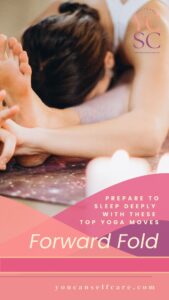
Get ready to experience a deep sense of release in your hamstrings and lower back with the forward fold pose. This powerful yoga move is perfect for those who desire mastery over their flexibility and relaxation.
The benefits of the forward fold are immense. Not only does it stretch and strengthen your hamstrings, calves, and hips, but it also helps to relieve tension in your lower back. As you fold forward, allow yourself to surrender into the pose, feeling a gentle stretch throughout your entire body.
For those who are just starting out on their yoga journey, variations of the forward fold can be done with bent knees or using props such as blocks or blankets for support. As you progress in your practice, you can deepen the stretch by straightening your legs or reaching for your toes.
Remember to listen to your body and find what feels right for you. With consistent practice, the forward fold will become an essential part of preparing for a deep and restful sleep.
Corpse Pose

Now that you've experienced the rejuvenating benefits of the Forward Fold, it's time to explore the ultimate relaxation pose: Corpse Pose. This posture is an essential part of any deep sleep routine as it allows you to release tension and improve relaxation in your entire body.
In Corpse Pose, lie on your back with your legs extended and arms relaxed by your sides. Close your eyes and take slow, deep breaths, allowing yourself to fully surrender to gravity. Feel the weight of your body sinking into the ground, releasing any lingering stress or tightness.
With each exhale, feel a wave of tranquility washing over you, bringing a sense of calmness and serenity.
Corpse Pose is not just about physical rest; it's also an opportunity to quiet the mind and let go of any mental burdens. Embrace this pose as a sacred moment for complete surrender and prepare yourself for a night of deeply restful sleep.
Shoulder Stand
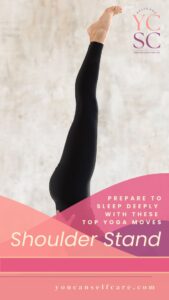
In the shoulder stand pose, you can stimulate your thyroid gland and improve circulation. This pose helps to activate and regulate the thyroid gland, which is responsible for metabolism. By putting pressure on the throat area, it also aids in improving blood flow throughout the body. Additionally, the inverted position promotes a sense of relaxation and tranquility in your nervous system.
Stimulate the Thyroid Gland
Boost your energy levels and feel a sense of vitality by incorporating these invigorating yoga poses to stimulate the thyroid gland. The thyroid gland plays a crucial role in regulating metabolism and balancing hormones, so it's important to keep it functioning optimally.
Here are four yoga poses that can help stimulate the thyroid gland:
- Supported Shoulderstand (Salamba Sarvangasana): This pose allows for increased blood flow to the neck region, stimulating the thyroid gland.
- Fish Pose (Matsyasana): By opening up the throat and chest, this pose helps activate the thyroid gland.
- Plow Pose (Halasana): Similar to Shoulderstand, Plow Pose also increases blood flow to the neck area, supporting healthy thyroid function.
- Bridge Pose (Setu Bandhasana): This pose stretches and strengthens the neck muscles, promoting proper circulation to the thyroid gland.
Incorporating these poses into your yoga routine can help boost metabolism and balance hormones, leading to improved overall health and well-being.
Improve Circulation
Enhance your blood flow and improve your overall health by incorporating these invigorating yoga poses to improve circulation.
Increasing blood flow is essential for optimal functioning of the body and can have a positive impact on various aspects of your health. These specific yoga moves are designed to stimulate blood circulation, helping to deliver oxygen and nutrients to all parts of your body while also removing waste products.
By practicing these poses regularly, you can increase blood flow, which in turn can reduce inflammation and promote healing throughout your body. Improved circulation not only benefits your physical health but also enhances mental clarity and overall well-being.
So, get ready to feel rejuvenated as you incorporate these yoga poses into your daily routine and experience the incredible benefits they bring.
Calm the Nervous System
Relax and unwind with these soothing yoga poses that bring a sense of calm to your nervous system. As you settle into each pose, focus on deepening your breath and releasing any tension in your body.
To reduce stress and promote relaxation, try incorporating these two techniques:
- Alternate Nostril Breathing: Close your right nostril with your thumb and inhale deeply through the left nostril. Then, close the left nostril with your ring finger and exhale through the right nostril. Repeat this pattern for several rounds, allowing each breath to become slower and more rhythmic.
- Legs-Up-The-Wall Pose: Lie on your back with your legs extended up against a wall or sturdy surface. This gentle inversion helps to increase blood flow to the brain while calming the nervous system.
By practicing these techniques regularly, you can experience the benefits of deep breathing and find greater peace within yourself as you prepare for a restful night's sleep.
Alternate Nostril Breathing

Take a deep inhale and let the soothing rhythm of alternate nostril breathing guide you towards tranquility, as if you're being cradled by a gentle breeze. This powerful technique can improve your focus and reduce anxiety, allowing you to prepare for a deep and restful sleep.
As you sit comfortably, close your eyes and bring your right hand to your face. Gently press your thumb against your right nostril to close it off, then exhale through your left nostril.
Inhale deeply through the same left nostril, then use your ring finger to close it off while releasing your thumb from the right nostril. Exhale through the right side, inhale again, and repeat this pattern for several minutes.
With each breath, feel tension melting away and a sense of calm washing over you.
Frequently Asked Questions
Can these yoga poses help with insomnia and improve sleep quality?
Yoga has been shown to significantly improve sleep quality and help with insomnia. By incorporating specific yoga poses into your routine, you can experience a deep and restful sleep. These poses work by reducing stress, calming the mind, and relaxing the body.
Yoga also promotes mindfulness and relaxation techniques that can be applied before bed to enhance sleep quality. Incorporating yoga into your daily practice will lead to mastery over insomnia, allowing for a peaceful night's rest.
Are there any modifications or variations for these yoga poses that can be done for individuals with limited flexibility or physical restrictions?
To overcome physical limitations and enhance your yoga practice, embrace the power of modifications and variations. Limited flexibility can be addressed through gentle adjustments that make poses accessible to you. For instance, using blocks or straps can provide support and stability.
Meanwhile, individuals with physical restrictions can explore alternative poses or adapt existing ones to cater to their unique needs. By embracing these modifications and variations, you'll unlock new dimensions of mastery in your yoga journey.
How long should each yoga pose be held to maximize its sleep-inducing benefits?
To maximize the sleep-inducing benefits of each yoga pose, it's ideal to hold them for an extended duration. Aim to stay in each pose for at least 5-10 minutes, allowing your body and mind to fully relax.
This extended time helps activate the parasympathetic nervous system, promoting deep relaxation and preparing you for a restful slumber. By dedicating enough time to these poses, you can fully reap their sleep-enhancing effects and achieve mastery over your bedtime routine.
Can practicing these yoga poses before bed help with reducing stress and anxiety?
Yoga poses can indeed be incorporated into a bedtime routine to help reduce stress and anxiety. By practicing these poses before bed, you can experience the calming effects of yoga on your overall well-being.
Yoga has been shown to lower cortisol levels and activate the relaxation response in the body, promoting a sense of peace and tranquility. So if you're looking to master your stress and anxiety, try adding these yoga poses to your nightly routine.
Are there any precautions or contraindications associated with these yoga poses that individuals should be aware of before attempting them?
Before attempting these yoga poses, it's crucial to be aware of certain precautions and contraindications. Listen closely, as your mastery-seeking mind deserves this vital knowledge.
Remember that if you have any existing injuries or medical conditions, consulting with a healthcare professional is imperative.
Furthermore, pregnant individuals should exercise caution while practicing certain poses that involve deep twists or inversions.
By being mindful of these precautions and contraindications, you can ensure a safe and beneficial yoga practice.
Conclusion
As you wind down your yoga practice, take a moment to appreciate the tranquility that awaits you. Sink into Child's Pose, like a tender bud nestled in a garden of serenity.
Let Legs-Up-The-Wall Pose lift you higher, like a gentle breeze carrying your worries away. As you fold forward, feel the weight of the world release from your shoulders, like leaves falling gracefully from trees.
Finally, surrender to Corpse Pose and become one with stillness, as if floating on a calm sea under a starlit sky. With these powerful poses and soothing breaths, prepare to drift into a deep and restful sleep.
Get Your Free Printable Guide, "Transform Your Self-Care Routine in 7 Days," and Unlock the Secrets of Health and Happiness. Click Here
Hi! Are you ready for some 'Me-Time'?


